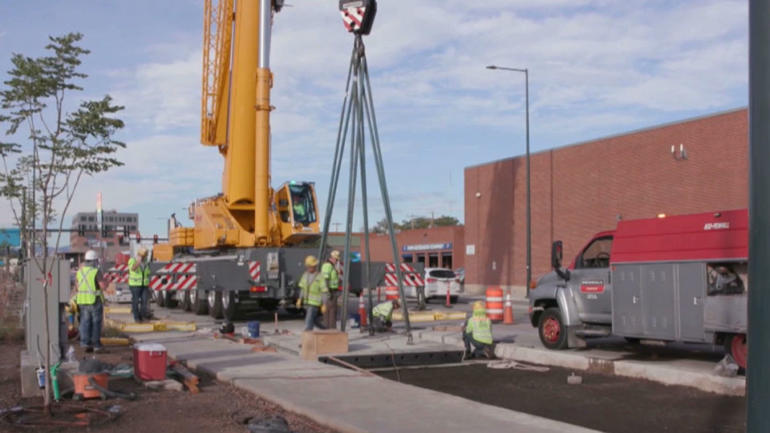Streets are being transformed into digital networks with a “smart pavement” concept being tested in Colorado. Roadways are embedded with technology that provides real-time traffic information. It could save time and maybe even save lives. CGTN’s Hendrik Sybrandy reports.
On Brighton Boulevard in Denver, it looks like ordinary road work.
CGTN’s Hendrik Sybrandy reports.
“This morning we’re installing the first four smart pavement slabs,” said Tim Sylvester, President of Integrated Roadways.
But this repaving operation and this concrete are a bit unusual.
“Smart pavement has inside a fiber optic sensing cable that makes the road touch sensitive,” said Sylvester, the founder of the Missouri company. Its mission is turning the roads of tomorrow into digital networks, providing information to drivers and gathering information about roads and highways, using the latest technologies.
“Sensors, antennas, the sky’s the limit, or the road’s the limit,” Sylvester said.
Four years ago, a car traveling on Colorado Highway 285 slid off the road and down a steep embankment. The driver was trapped inside the vehicle in below freezing temperatures, without food and water, for six days. The driver survived, but the accident prompted the Colorado Department of Transportation to green light this test project, which it claims is the first in the world.
It believes smart pavement using embedded technology, transmitting real-time data, could prevent a repeat.
“This will be able to tell us how the wheels of a vehicle are moving around and notify emergency responders if it senses those vehicles leave the road in an unsafe way,” said Peter Kozinski, CDOT’s RoadX Program Director.
Besides the safety functions, Sylvester said at a time when road-building is more expensive than ever, traffic information from these slabs could eventually be sold to customers to offset construction costs, the way Google and Facebook sell data from Internet traffic.
“So by putting the data collection and telecom into the road, the road pays for itself and we no longer have to worry about how the road gets funded,” Sylvester said.
Roads also offer promise in other ways. Smart pavement could eventually help autonomous cars navigate better. China is testing highways covered with solar panels as a way to produce power.
“The idea of inductive charging – could you have coils within the pavement that could provide power to electric vehicles?” Kozinski said.
The Colorado Department of Transportation said deploying this type of concrete on a widespread basis is probably unrealistic, but worth testing.
“We think this could really be a good tool to have in our toolbox,” Kozinski said.
This $200,000 installation could soon be replicated at the scene of that 2014 accident. Roads are taking on new dimensions these days as we merge onto the highway of the future.
 CGTN America
CGTN America

